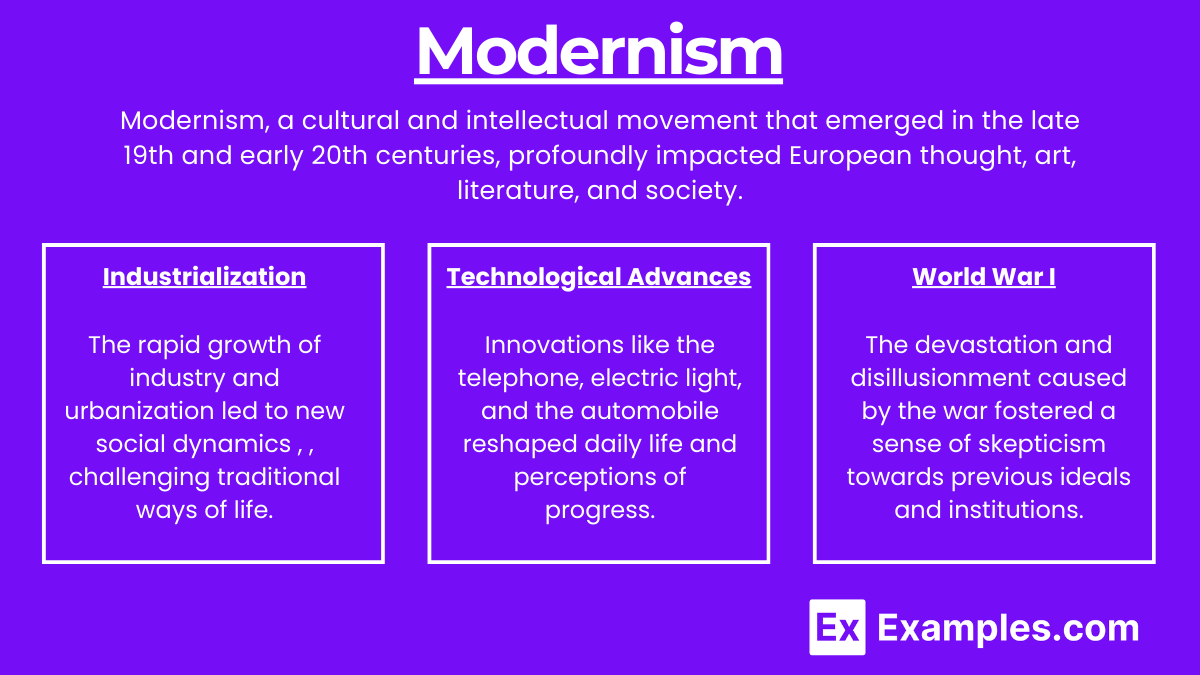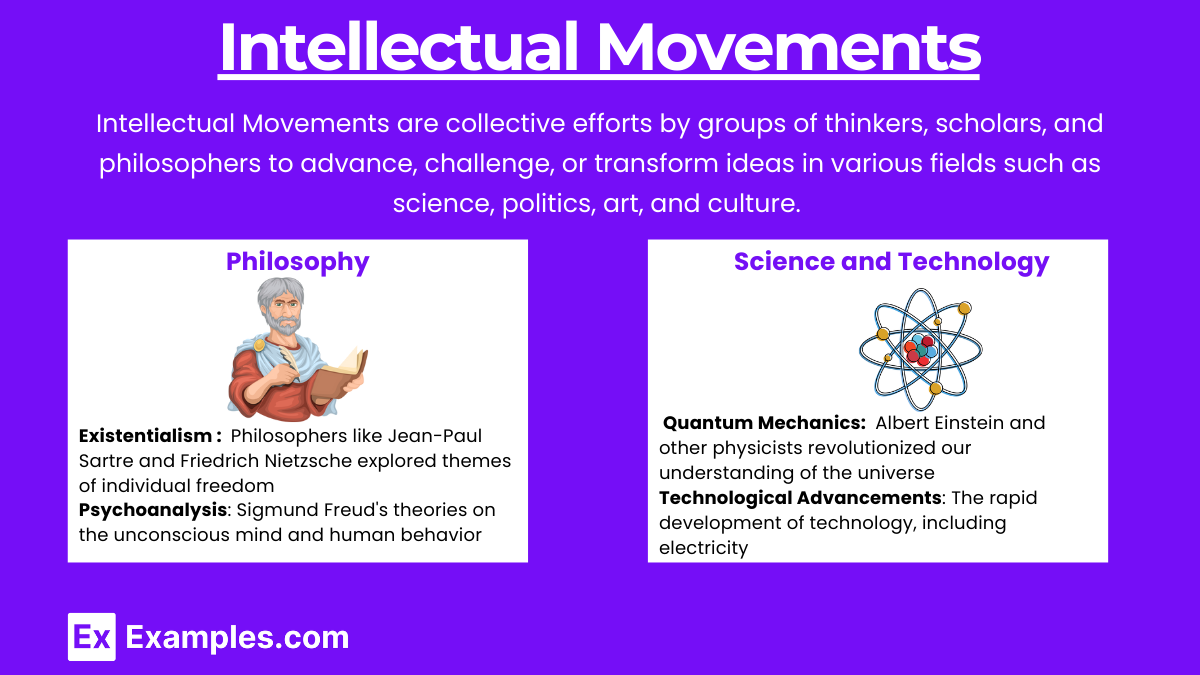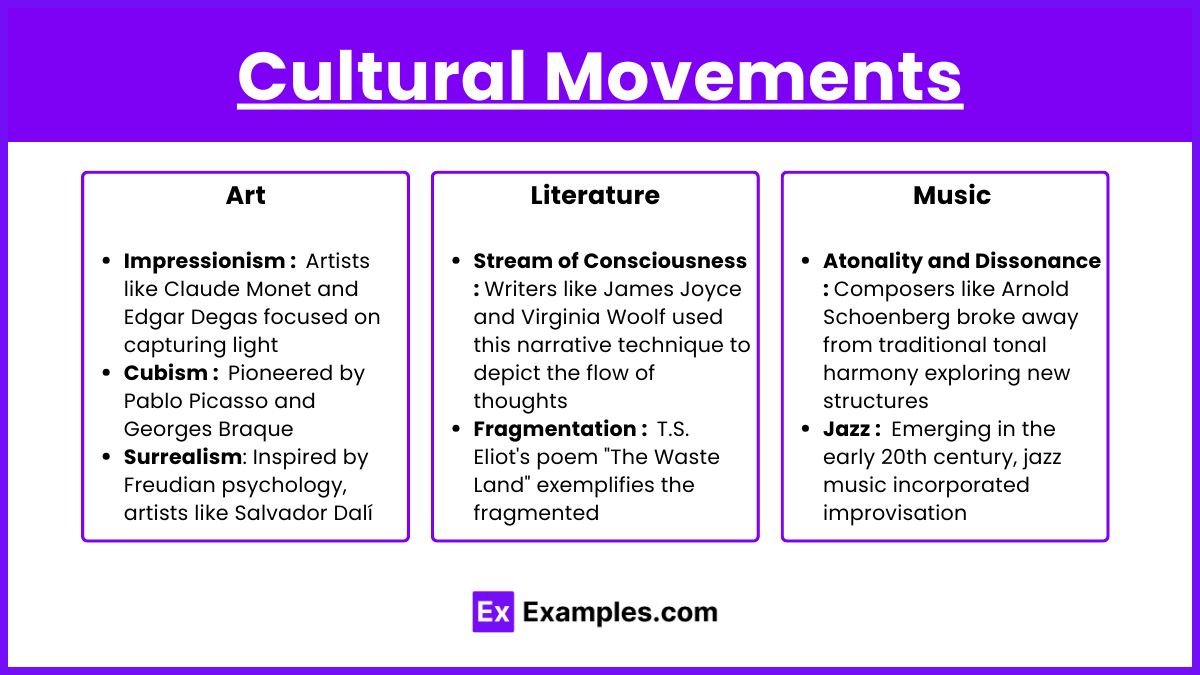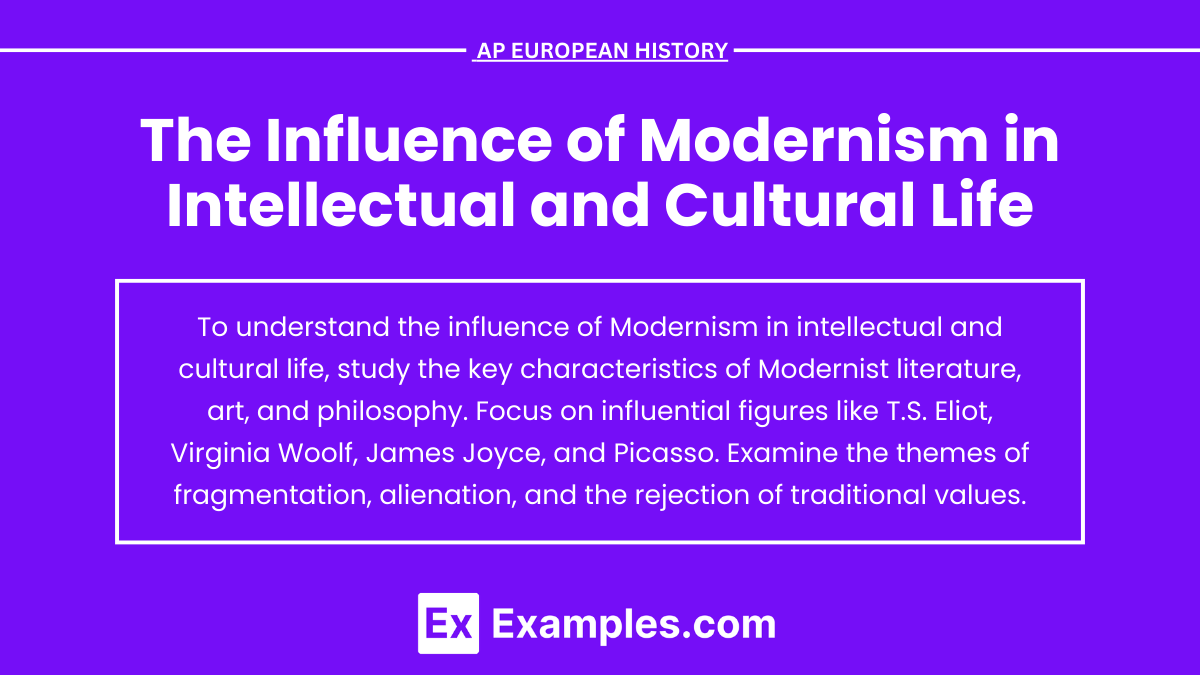Modernism, emerging in the late 19th and early 20th centuries, revolutionized European intellectual and cultural life by challenging traditional norms and embracing innovation. This movement, characterized by a focus on individual experience, experimentation, and a rejection of established conventions, profoundly impacted art, literature, philosophy, and society. In AP European History, students explore how modernist thinkers and artists sought to capture the complexities of modern life through new forms and techniques, reflecting the rapid changes in science, technology, and social structures of their time.
Learning Objectives
By studying "The Influence of Modernism in Intellectual and Cultural Life" for the AP European History exam, you should learn to identify and explain the key characteristics and themes of Modernism, recognize major figures and their contributions in art, literature, philosophy, and music, and understand how Modernism challenged traditional norms and influenced societal changes. Additionally, you should be able to analyze the impact of scientific and technological advancements on Modernist thought and appreciate the movement's lasting effects on contemporary culture and intellectual discourse.
Modernism

Modernism, a cultural and intellectual movement that emerged in the late 19th and early 20th centuries, profoundly impacted European thought, art, literature, and society. It represented a break from traditional forms and embraced innovation, experimentation, and a quest for new perspectives.
Origins and Context of Modernism
Modernism arose as a reaction against the established norms of the 19th century, characterized by realism and romanticism. The following factors contributed to the rise of modernism:
Industrialization: The rapid growth of industry and urbanization led to new social dynamics, challenging traditional ways of life.
Technological Advances: Innovations like the telephone, electric light, and the automobile reshaped daily life and perceptions of progress.
World War I: The devastation and disillusionment caused by the war fostered a sense of skepticism towards previous ideals and institutions.
Key Characteristics of Modernism
Modernism is marked by several defining features:
Rejection of Tradition: Modernists sought to break away from classical forms and conventions, embracing experimentation and innovation.
Emphasis on Subjectivity: Focused on individual perception and experience, modernist works often explored the inner psyche and consciousness.
Fragmentation: Modernist literature and art frequently employed fragmented structures, reflecting the complexity and disarray of modern life.
Absurdity and Alienation: Themes of existentialism and the absurd, questioning the meaning of life and the human condition, were prevalent.
Intellectual Movements

Intellectual Movements are collective efforts by groups of thinkers, scholars, and philosophers to advance, challenge, or transform ideas in various fields such as science, politics, art, and culture. These movements aim to influence society’s views and beliefs, often leading to significant cultural or social change. For instance, in philosophy, existentialism, explored by Jean-Paul Sartre and Friedrich Nietzsche, delves into themes of individual freedom, choice, and the meaning of existence. In psychoanalysis, Sigmund Freud's theories on the unconscious mind and human behavior profoundly influenced modernist thinkers and artists. In science and technology, the development of relativity and quantum mechanics by Albert Einstein and other physicists revolutionized our understanding of the universe, challenging traditional Newtonian physics. Furthermore, rapid technological advancements in electricity, automobiles, and telecommunications transformed everyday life and shaped modernist thought.
Philosophy
Existentialism: Philosophers like Jean-Paul Sartre and Friedrich Nietzsche explored themes of individual freedom, choice, and the meaning of existence.
Psychoanalysis: Sigmund Freud's theories on the unconscious mind and human behavior influenced many modernist thinkers and artists.
Science and Technology
Relativity and Quantum Mechanics: Albert Einstein and other physicists revolutionized our understanding of the universe, challenging traditional Newtonian physics.
Technological Advancements: The rapid development of technology, including electricity, automobiles, and telecommunication, transformed everyday life and influenced modernist thought.
Cultural Movements

Art
Impressionism: Artists like Claude Monet and Edgar Degas focused on capturing light and movement, emphasizing personal perception over realistic representation.
Cubism: Pioneered by Pablo Picasso and Georges Braque, Cubism broke objects into geometric shapes, representing multiple viewpoints simultaneously.
Surrealism: Inspired by Freudian psychology, artists like Salvador Dalí and René Magritte explored the irrational and dreamlike aspects of the human mind.
Literature
Stream of Consciousness: Writers like James Joyce and Virginia Woolf used this narrative technique to depict the flow of thoughts and feelings within a character's mind.
Fragmentation: T.S. Eliot's poem "The Waste Land" exemplifies the fragmented, collage-like style that characterizes much of modernist literature.
Music
Atonality and Dissonance: Composers like Arnold Schoenberg broke away from traditional tonal harmony, exploring new structures and sounds.
Jazz: Emerging in the early 20th century, jazz music incorporated improvisation and complex rhythms, influencing both popular and classical music.
Impact on Society
Women's Rights: The modernist period saw significant advances in women's suffrage and gender equality, influenced by new ways of thinking about individual rights and social roles.
Urbanization: Rapid urbanization and industrialization during this period transformed social structures and living conditions, reflected in modernist works that depicted the alienation and dynamism of city life.
Interdisciplinary Studies: Modernist thought encouraged the breaking down of traditional academic boundaries, leading to the development of interdisciplinary studies.
Critical Theory: Scholars like the Frankfurt School applied modernist principles to critique culture and society, examining the relationship between ideology, power, and art.
Examples
Example 1 : Literature
James Joyce's "Ulysses"
Joyce's "Ulysses" exemplifies modernist literature with its stream-of-consciousness technique, nonlinear narrative, and deep exploration of the protagonist's inner thoughts and experiences throughout a single day in Dublin.
Virginia Woolf's "Mrs. Dalloway"
Woolf's "Mrs. Dalloway" breaks from traditional storytelling by using stream-of-consciousness and free indirect discourse, offering a deep psychological portrait of its characters and reflecting the fragmented nature of modern life.
Example 2 : Visual Arts
Pablo Picasso's "Les Demoiselles d'Avignon"
Picasso's "Les Demoiselles d'Avignon" is a seminal work in modern art, showcasing Cubism's radical departure from traditional perspective and representation, instead using geometric shapes and fragmented forms to depict its subjects.
Salvador Dalí's "The Persistence of Memory"
Dalí's "The Persistence of Memory" illustrates Surrealism's influence on modern art, with its dream-like, fantastical imagery and melting clocks challenging conventional perceptions of reality and time.
Example 3 : Architecture
Le Corbusier's Villa Savoye
Le Corbusier's Villa Savoye is an iconic example of modernist architecture, emphasizing functionality, clean lines, and the use of concrete, steel, and glass. It embodies the principles of the International Style and the idea of a house as a "machine for living."
Example 4: Music
Igor Stravinsky's "The Rite of Spring"
Stravinsky's "The Rite of Spring" revolutionized classical music with its unconventional rhythms, dissonant harmonies, and innovative orchestration, reflecting the modernist desire to break from traditional forms and explore new artistic expressions.
Example 5 : Film
Fritz Lang's "Metropolis"
Lang's "Metropolis" is a landmark in modernist cinema, using innovative special effects, set designs, and narrative techniques to depict a dystopian future. It explores themes of industrialization, social disparity, and the human condition in the modern age.
Multiple Choice Questions
Question 1
Which of the following is a key characteristic of modernism in intellectual and cultural life?
A. Emphasis on tradition and continuity
B. Rejection of established conventions
C. Focus on realistic representation
D. Promotion of rural and agrarian lifestyles
Answer: B. Rejection of established conventions
Explanation:
Modernism is characterized by a deliberate break from traditional forms and conventions. Modernist thinkers and artists sought to challenge and redefine the existing norms in art, literature, architecture, and society. They emphasized innovation, experimentation, and a quest for new forms of expression. This rejection of established conventions is a defining feature of the modernist movement.
Question 2
Which of the following movements is most closely associated with the principles of modernism?
A. Romanticism
B. Realism
C. Futurism
D. Naturalism
Answer: C. Futurism
Explanation:
Futurism is a movement closely associated with modernism, particularly because of its embrace of new technologies, dynamic movement, and the idea of progress. Futurists celebrated the energy and dynamism of modern technology, rejecting the past and traditional artistic forms. This aligns with the modernist emphasis on breaking away from historical precedents and exploring new ways of thinking and creating.
Question 3
How did modernism influence the approach to literature and narrative form?
A. By maintaining linear storytelling and clear moral lessons
B. By adopting fragmented structures and stream-of-consciousness techniques
C. By focusing exclusively on heroic epics
D. By promoting clear and straightforward language
Answer: B. By adopting fragmented structures and stream-of-consciousness techniques
Explanation:
Modernism had a profound impact on literature, particularly through its experimental approaches to narrative form. Authors like James Joyce and Virginia Woolf adopted fragmented structures and stream-of-consciousness techniques to capture the complexity of human thought and experience. This departure from traditional linear storytelling allowed modernist writers to explore deeper psychological and existential themes, reflecting the broader modernist quest for new forms of expression.


